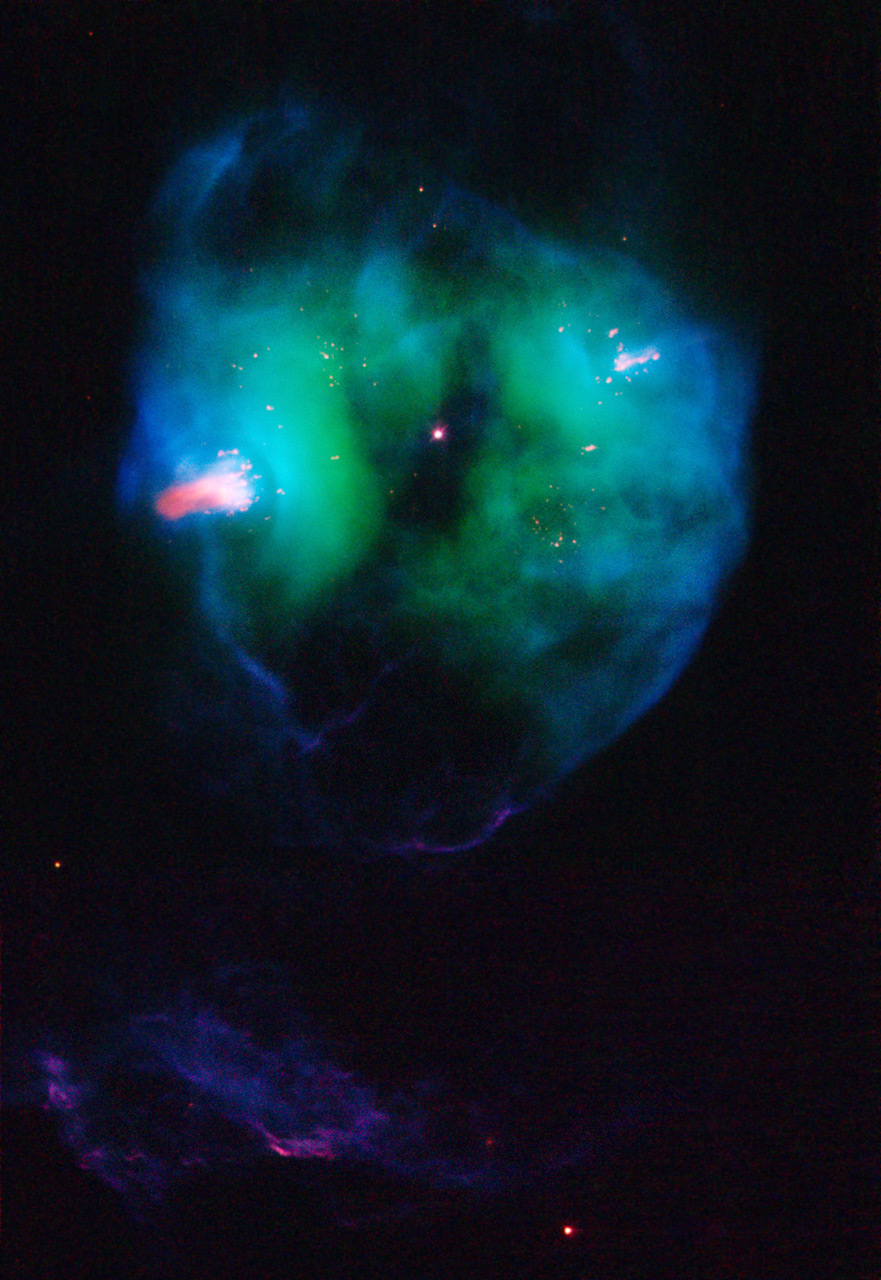허블 우주망원경이 불타오르는 가스와 먼지 구름에 의해 둘러싸여 최후를 맞고 있는 별을 탐색함으로써, 이전에는 볼 수 없었던 구조를 밝혀내었다.
이 천체는 NGC 2371이라 불리는 행성상성운으로 우리 태양과 같은 별의 잔해가 불타오르고 있는 모습을 보여주고 있다.
사진의 정 중앙에 보이는 잔해는 이전 적색 거성 단계의 매우 뜨거운 중심핵으로서 지금은 별의 외피 부분을 모두 벗어던진 상태이며, 그 표면 온도는 무려 13만 도에 달한다.
NGC 2371은 쌍둥이 자리에 4300 광년 떨어져 있다.
허블이 촬영한 사진에는 몇몇 눈길을 끄는 구조들이 보이는데, 이들 중 가장 주목할 만한 분홍색 구름이 중앙 별의 반대 방향으로 위치하고 있다.
이러한 색채가 나타나는 이유는 이들을 구성한 가스가 이 성운의 여타 부분에 비해 상대적으로 차갑고 높은 밀도를 가지고 있기 때문이다.
또한 수많은 작은 분홍색의 점들 역시 상대적으로 밀도가 높은 지역들이며 별의 정반대 방향으로 분포하고 있다.
이 구조들은 별로부터 분출된 가스들이 특정한 방향을 따라 분출되었음을 알려준다.
이 분출기류들은 지난 수천년에 걸쳐 방향이 변화되어 왔다.
이러한 변화 원인은 알려져 있지 않지만, 아마도 사진에 보이는 중앙의 별을 공전하는 다른 별이 연관된 것으로 추측된다.
행성상 성운은 하나의 별이 일생을 마칠 때 뿜어낸 가스 구름이 팽창하면서 발생하는 천체이다.
이 구름들은 중앙에 위치한 뜨거운 별의 잔해로부터 발생하는 자외선 복사에 의해 불타오른다.
몇 천년 내에 이 구름들은 우주 공간으로 흩어지게 될 것이다.
그렇게 되면 중앙의 별은 천천히 식게 될 것이고, 결국 별의 진화단계에서 마지막 단계인 백색 왜성이 될 것이다.
이 사진은 인위적인 색채를 입힌 사진으로서 황과 질소는 붉은 색으로, 수소는 녹색으로 그리고 산소는 파란색으로 표시되어 있다.
이 사진은 허블 헤리티지 프로그램의 일환으로서 2007년 11월 2일, 허블 광대역행성카메라2(WFPC2)로 촬영되었다.
* '허블사이트'의 게시물들은 허블사이트 http://hubblesite.org 의 뉴스센터 자료들을 번역한 자료들입니다.
본 내용은 2008년 3월 4일 발표된 뉴스입니다.
원문>
ABOUT THIS IMAGE:
Probing a glowing bubble of gas and dust encircling a dying star, NASA's Hubble Space Telescope reveals a wealth of previously unseen structures.
The object, called NGC 2371, is a planetary nebula, the glowing remains of a Sun-like star. The remnant star visible at the center of NGC 2371 is the super-hot core of the former red giant, now stripped of its outer layers. Its surface temperature is a scorching 240,000 degrees Fahrenheit. NGC 2371 lies about 4,300 light-years away in the constellation Gemini.
The Hubble image reveals several remarkable features, most notably the prominent pink clouds lying on opposite sides of the central star. This color indicates that they are relatively cool and dense, compared to the rest of the gas in the nebula.
Also striking are the numerous, very small pink dots, marking relatively dense and small knots of gas, which also lie on diametrically opposite sides of the star. These features appear to represent the ejection of gas from the star along a specific direction. The jet's direction has changed with time over the past few thousand years. The reason for this behavior is not well understood, but might be related to the possible presence of a second star orbiting the visible central star.
A planetary nebula is an expanding cloud of gas ejected from a star that is nearing the end of its life. The nebula glows because of ultraviolet radiation from the hot remnant star at its center. In only a few thousand years the nebula will dissipate into space. The central star will then gradually cool down, eventually becoming a white dwarf, the final stage of evolution for nearly all stars.
The Hubble picture of NGC 2371 is a false-color image, prepared from exposures taken through filters that detect light from sulfur and nitrogen (red), hydrogen (green), and oxygen (blue). These images were taken with Hubble's Wide Field Planetary Camera 2 in November 2007, as part of the Hubble Heritage program.
For additional information, contact:
Ray Villard
Space Telescope Science Institute, Baltimore, Md.
410-338-4514
villard@stsci.edu
Keith Noll/Howard Bond
Space Telescope Science Institute, Baltimore, Md.
410-338-1828/4718
noll@stsci.edu/bond@stsci.edu
Object Name: NGC 2371
Image Type: Astronomical
Credit: NASA, ESA, and the Hubble Heritage Team (STScI/AURA)
'3. 천문뉴스 > 허블사이트' 카테고리의 다른 글
| 오메가 센타우리(NGC 5139)의 블랙홀 (0) | 2008.04.22 |
|---|---|
| GRB 080319B (0) | 2008.04.20 |
| A1689-zD1 : 중력렌즈효과를 통해 발견한 원시은하 (0) | 2008.02.28 |
| NGC 1132 (0) | 2008.02.07 |
| NGC 602, N90 (0) | 2008.01.28 |
